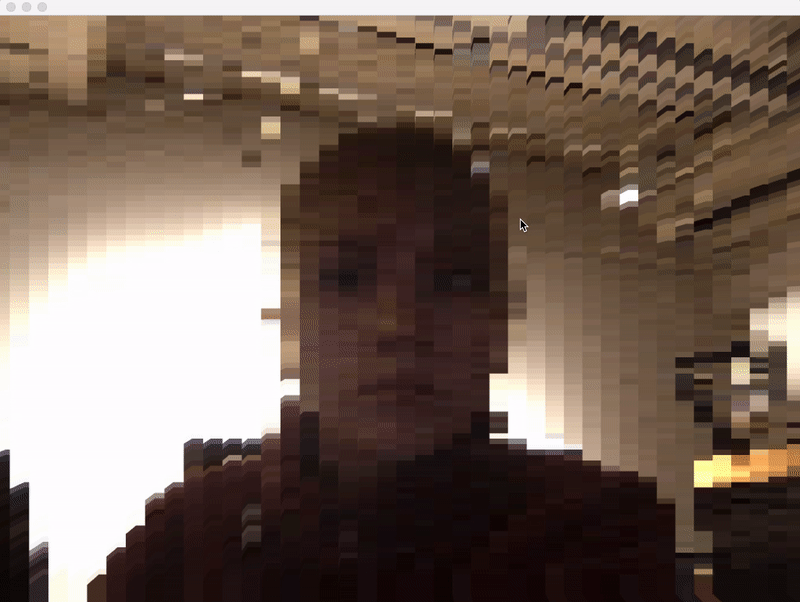The aim of this project is to recreate the act of being constantly observed online with and without consent. It refers to different kinds of observation: data collection, image-taking, video-recording, typing, clicking, and the physical looking that makes us modern voyeurs. The act of recording data is intertwined with contemporary society, and through this piece I aim to explore this in an abstract way. This work was inspired by a work of Kate Hollenbach, in which she created a mobile-friendly website that showed one’s physical touch on the phone to any other users on the same site. The idea of your physical touch being tracked and viewed by others on the internet was really intriguing to me. Another influence of this piece was Daniel Rozin, who has a series of interactive installations, most of which are labeled as mirrors. He engages in a kind of abstract visualization, where in many cases the viewer becomes either a catalyst to the work or the content of the work. Although they do not all necessarily reflect one’s light back at themselves as glass would, they are still acting as a mirror because the data we put out or is taken about us is in some way a reflection of who we are, and a new kind of portrait. I really like this play on interaction along with the viewer-work relationship that results from it.
This work speaks primarily about human’s experience with technology. The inside of the book reads ambiguous text, images, screenshots, etc. specifically chosen, curated, and redacted by me to represent the idea of the web not only taking as much information as it wants, but also actively censoring and curating the information it is giving to us. It also acts as a means to hint to the reader that they are being observed, without outwardly saying it. Social media is used as a tool to promote, make connections, push idealizations, seek validation, and most of all acts as a tool and a trigger for contemporary voyeurism – making those who use it and those who make it psychologically wired to be voyeurs, while simultaneously remaining anonymous in the sense where one denies their own participation.
This project has hidden flex sensors hidden in each page while all mechanics and wiring are hidden in a false cover, giving the illusion that this is a normal book and to emphasize the lack of consent. It is at a medium scale, making it as nondescript as possible. The work exists is in book form to flip the idea of informational access, using a tangible object where we usually get information from to act as a source of collecting information (somewhat like a smart phone). In addition, the work has a webcam element, that outputs the ‘information’ taken from the book’s reader. The output acts as a mirror, representing the data being taken live from the book and combining it with the live video feed of the user. The sensors play a role by affecting the outcome of the image, speaking to the curation, censorship, and data recording that occurs throughout social media.
Inside of the book is a designed series of pages using different social media screenshots, the businesses’ user agreements, typography, and mirror paper. Below are the digital file of each page, but I further manipulated them after executing the circuitry necessary.
Throughout the prototyping and entire process of creating Facebook, it took various technical skills to bring the project to completion. A heavy component of the work had to be done in the coding, for both the physical sensors (Arduino and flex sensors) and the screen-based web visualization (openFrameworks). In addition, in order for the code to correctly flow through and ultimately alter the output, soldering the physical wiring and all the components of the Arduino and sensors was necessary. To finish off the physical structure, I laser cut the pieces necessary to create the book based on my prototype (above). Also necessary for this project was a sense of composition and graphic design, implemented in the pages and cover design (and made using Illustrator, Photoshop, InDesign). An immense amount of problem solving was consistent throughout the entire process. Some conflicts included: designing the physical structure of the book so that it can open and close, making the pages turn while bending the sensors correctly, attaching the pages while keeping them flat when the book is closed, hiding the wires and attaching them to the pages so the book can still open properly, etc.
To hide the flex sensor in each page, I used conductive fabric tape and copper tape to carry the connections to the Arduino without effecting the flatness of the page. Where the tape was in a place where it would no longer be seen, I soldered the data, power, and ground wires. I then glued the other page on top to hide the mechanism. Once each page was finished, I inserted them each into their respective slots and soldered the connections: first, to each other, and then to the Arduino. The Arduino was connected to my computer via USB and the computer to the distorted television via HDMI.

















